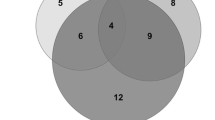Abstract
Purpose
To investigate long-term structural and functional progression of untreated and treated glaucoma suspects (UGS and TGS).
Methods
Retrospective analysis of serial steady-state pattern electroretinogram (PERG), mean retinal nerve fiber layer thickness (RNFLT), and standard automated perimetry mean deviation (SAP-MD) in UGS (N = 20) and TGS (N = 18). Outcome measures were the rates of change (linear regression slopes) of PERG amplitude, PERG phase, mean RNFLT, and SAP-MD over 9.8 ± 1.3 years (15.6 ± 4.2 visits).
Results
The number of patients with significant (P < 0.05) progression slopes for PERG amplitude, PERG phase, RNFLT, and SAP-MD was, respectively, UGS: 5, 0, 4, 2; TGS: 8, 2, 6, 5. In UGS, outcome measures were not correlated with each other. In TGS, both PERG amplitude and RNFLT were significantly (P < 0.05) correlated with SAP-MD (R ≥ 0.58), while PERG amplitude and RNFLT were not correlated with each other (R = 0.43, P = 0.064). The rate of change of SAP-MD was predicted (P < 0.05) by a linear combination of RNFLT slope and PERG amplitude slope.
Conclusions
Results substantiate and extend previous results showing that steady-state PERG amplitude progressively decreased over time in a proportion of glaucoma suspects, with relatively steeper slope in TGS compared to UGS. RNFLT progression also had a steeper slope in TGS compared to UGS; however, progressions of PERG amplitude and RNFLT were not significantly correlated. Both PERG progression and RNFLT progression independently contribute to prediction of visual field progression.




Similar content being viewed by others
References
Bach M et al (2013) ISCEV standard for clinical pattern electroretinography (PERG): 2012 update. Doc Ophthalmol 126(1):1–7
Bach M, Hoffmann MB (2008) Update on the pattern electroretinogram in glaucoma. Optom Vis Sci 85(6):386–395
Bach M, Poloschek CM (2013) Electrophysiology and glaucoma: current status and future challenges. Cell Tissue Res 353(2):287–296
Bach M, Ramharter-Sereinig A (2013) Pattern electroretinogram to detect glaucoma: comparing the PERGLA and the PERG ratio protocols. Doc Ophthalmol 127(3):227–238
Ventura LM, Porciatti V (2006) Pattern electroretinogram in glaucoma. Curr Opin Ophthalmol 17(2):196–202
Wilsey LJ, Fortune B (2016) Electroretinography in glaucoma diagnosis. Curr Opin Ophthalmol 27(2):118–124
Banitt MR et al (2013) Progressive loss of retinal ganglion cell function precedes structural loss by several years in glaucoma suspects. Invest Ophthalmol Vis Sci 54(3):2346–2352
Ventura LM, Feuer WJ, Porciatti V (2012) Progressive loss of retinal ganglion cell function is hindered with IOP-lowering treatment in early glaucoma. Invest Ophthalmol Vis Sci 53(2):659–663
Ventura LM et al (2013) Pattern electroretinogram progression in glaucoma suspects. J Glaucoma 22(3):219–225
Bode SF, Jehle T, Bach M (2011) Pattern electroretinogram in glaucoma suspects: new findings from a longitudinal study. Invest Ophthalmol Vis Sci 52(7):4300–4306
Ventura LM et al (2005) Pattern electroretinogram abnormality and glaucoma. Ophthalmology 112(1):10–19
Gordon MO, Kass MA (1999) The ocular hypertension treatment study: design and baseline description of the participants. Arch Ophthalmol 117(5):573–583
Walker RS, Pilts-Seymour JR (2009) When to treat glaucoma. In: Yanoff M, Ducker JS (eds) Ophthalmology. Mosby, Elsevier, London, p 1211–1215
Porciatti V et al (1992) The effects of aging on the pattern electroretinogram and visual evoked potential in humans. Vis Res 32(7):1199–1209
Porciatti V, Ventura LM (2004) Normative data for a user-friendly paradigm for pattern electroretinogram recording. Ophthalmology 111(1):161–168
Knight OJ et al (2009) Comparison of retinal nerve fiber layer measurements using time domain and spectral domain optical coherent tomography. Ophthalmology 116(7):1271–1277
Feuer WJ et al (2011) Topographic differences in the age-related changes in the retinal nerve fiber layer of normal eyes measured by Stratus optical coherence tomography. J Glaucoma 20(3):133–138
Draper NR, Smith H (1981) Applied linear regression analysis, 2nd edn. Wiley, New York
Na JH et al (2015) Rates and patterns of macular and circumpapillary retinal nerve fiber layer thinning in preperimetric and perimetric glaucomatous eyes. J Glaucoma 24(4):278–285
Chen TC et al (2018) Spectral-domain OCT: helping the clinician diagnose glaucoma: a report by the American Academy of Ophthalmology. Ophthalmology 125(11):1817–1827
Salgarello T et al (2018) Pattern electroretinogram detects localized glaucoma defects. Transl Vis Sci Technol 7(5):6
Kreuz AC et al (2018) Macular and multifocal PERG and FD-OCT in preperimetric and hemifield loss glaucoma. J Glaucoma 27(2):121–132
Bach M, Cuno AK, Hoffmann MB (2018) Retinal conduction speed analysis reveals different origins of the P50 and N95 components of the (multifocal) pattern electroretinogram. Exp Eye Res 169:48–53
Acknowledgements
This work was supported by NIH-NEI RO1 EY014957, NIH center Grant P30-EY014801, and by unrestricted Grant to Bascom Palmer Eye Institute from Research to Prevent Blindness, Inc.
Funding
This study was funded by NIH-NEI RO1 EY014957, NIH center Grant P30-EY014801, and unrestricted grant to Bascom Palmer Eye Institute from Research to Prevent Blindness, Inc.
Author information
Authors and Affiliations
Corresponding author
Ethics declarations
Conflict of interest
The authors declare that there is no conflict of interest regarding the publication of this article. The authors alone are responsible for the content and writing of the paper.
Statement of human rights
All procedures performed in studies involving human participants were in accordance with the ethical standards of the institutional and/or national research committee and with the 1964 Helsinki declaration and its later amendments or comparable ethical standards.
Informed consent
All individuals involved in the study were informed of the purpose of the study, and their informed consent was obtained. This study followed the tenets of the Declaration of Helsinki and was approved by the ethics committee of the institutional First Affiliated Hospital of Chongqing Medical University.
Statement on the welfare of animals
This article does not contain any studies with animals performed by any of the authors.
Additional information
Publisher's Note
Springer Nature remains neutral with regard to jurisdictional claims in published maps and institutional affiliations.
Rights and permissions
About this article
Cite this article
Gordon, P.S., Kostic, M., Monsalve, P.F. et al. Long-term PERG monitoring of untreated and treated glaucoma suspects. Doc Ophthalmol 141, 149–156 (2020). https://doi.org/10.1007/s10633-020-09760-5
Received:
Accepted:
Published:
Issue Date:
DOI: https://doi.org/10.1007/s10633-020-09760-5




